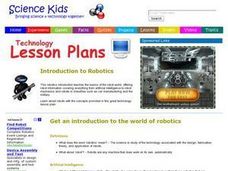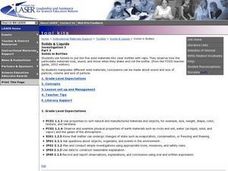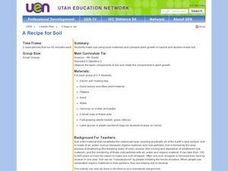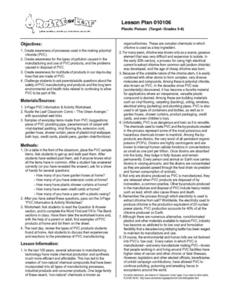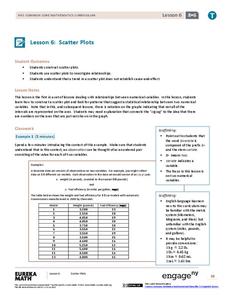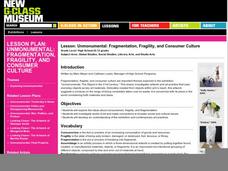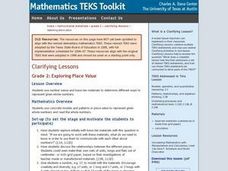Curated OER
French Cheese
High schoolers discover how cheese in France is made. Using the internet, they read articles about the importance of cheese in the French culture. They identify the various French cheeses and locate the areas in France that manufacture...
Curated OER
Introduction to Robotics
Students explore robots as it relates to artificial intelligence and mechanics. In this introduction to robotics lesson, students examine the technology related to design, research the concept of fabrication theory and the application of...
Curated OER
Solids in Bottles
Young scholars use funnels to put the five solid materials into clear bottles with caps. They observe how the particulate materials look, sound, and move when they shake and roll the bottle. Finally, students write "sound and touch"...
Curated OER
Tower O'Power
Students work together to design a tower from a computer program. They manufacture the pieces with a laser cutter and compete in a competition to determine the best design for stress relief on towers. They discover the work engineers...
Curated OER
Hardwood Veneer
Young scholars explore uses of hardwood veneer and the manufacturing process. They view veneer samples and work in groups to answer questions about the process of making veneer. After touring the school to create a list of products made...
Curated OER
A Recipe for Soil
Fourth graders use local materials such as leaves and other plant matter; sand and pebbles to make soil. They plant seeds in the manufactured soil and in natural soil and then observe and record the results.
Curated OER
Reclamation and Recycling
Young scholars examine the many uses of mined lands after reclamation has been completed and discover the importance of recycling finding the difference between manufacturing with recycled materials and newly extracted materials.
Curated OER
Plastic Poison
Students explore the processes used in the making of polyvinyl chloride (PVC). The types of pollution caused in the manufacturing and use and the problems in the disposal of this product is examined in this activity.
Curated OER
CONSTRUCTION OF A HEMOGLOBIN GENE
Young scholars use research to see how eight pairs of triplets are equivalent to part of a gene and control a part of heredity. They also understand how red blood corpuscles manufacture normal hemoglobin.
Curated OER
Reclamation and Recycling
Students learn the importance of plants and animals, ecosystems and habitats... and see how these factors guide mining reclamation projects. They then discover the importance of recycling, and the difference between manufacturing with...
Curated OER
Hold on Tight!
Students explore the mechanisms of how sticky materials work. In this technology lesson, students test the strength of different sticky tapes. They explain how their uses relate to how they are manufactured.
Curated OER
Coal: A Tree-mendous Resource
Students identify the many products manufactured using coal. After brainstorming, they create displays by making posters, a bulletin board, a mobile or a three-dimensional display.
Curated OER
THE TRAVELS OF BABAR: An Adventure in Scale :Building a Model Hot Air Balloon
Students encounter basic facts about helium and hot air. They compare the weight and size of different materials. Students work collaboratively in teams. They create their own model balloon.
Curated OER
Designing, BUilding & Planting Appropriate Style Plantings in a Planter Box
Students explore designing and building a plant box. Based upon desired parameters, students create a set of plant box blueprints. Next, they choose the material and build the box. Agricultural teams select the soil mixture, fertilizer...
Curated OER
Solid Waste Management
Sixth graders examine the role of packaging of everyday products and urge manufacturers to reduce the amount of it. They also discover how many products they use everyday can be recycled.
Curated OER
Children's Health: Children Aren't Little Adults
This lesson is a compilation of interdisciplinary, technology-infused activities that focus on the often complicated and sometimes controversial issues related to toxic chemicals in children's environment. Special emphasis is placed on...
Curated OER
Simple Everyday Products
Fourth graders investigate the origin of products and how they are manufactured from natural resources. They draw the production cycle and discuss how one could help reduce the number of natural resources that are used. They also...
EngageNY
Scatter Plots
Scholars learn to create scatter plots and investigate any relationships that exists between the variables with a lesson that also show them that statistical relationships do not necessarily indicate a cause-and-effect...
Curated OER
Lambert Castle Museum, Great Falls, NJ
Young scholars complete a variety of activities that go along with the study of the 1913 silk strike in Great Falls, NJ. They examine evidence of historic industries and how they have changed in their own community.
Curated OER
A Funny Thing Happened on the Way to the Mill
Students participate in a simulation of wool trading in the 1800's. They pass around a ball of yarn at various stations to simulate the interdependence of each stage of the wool trade, discuss what happens when there is a problem in the...
Curated OER
Sorting
A instructional activity on classification and sorting is here for you. Elementary schoolers participate in an interactive computer game in which they sort books by theme. They take a trip to the library to observe and discuss how books...
Curated OER
Lesson: Unmonumental: Fragmentation, Fragility, and Consumer Culture
Looking at art is the first step to analyzing it. And, if you can analyze art, you can analyze anything. Kids examine several pop art pieces that represent consumerism in modern culture. They discuss multiple facets of each piece and...
Curated OER
Grade 2: Exploring Place Value
Creative problem solving is fun and helps kids conceptualize content. They use grid paper, manilla paper, and markers to cut, draw, and show given double-digit numbers as many ways as they can.
Curated OER
Recycled Paper
Sixth graders keep track of the amount of paper they consume on a daily, weekly, and monthly basis. The goal of the lesson is to have them all find ways to reduce the amount they use. Everyone creates recycled paper from old newspapers...



